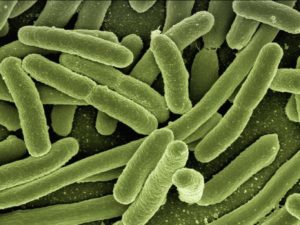Selected Publication Highlights (full list available here)
Worms that exercise have better mitochondria
Scientific Reports, 2018
An average lab worm spends its (on average, 17 days) life endlessly gobbling E. coli. It spends 2.5 days developing to adulthood, about 5 days having offspring, and then lives out its remaining 10 days in a steep decline in overall physiology. We have shown in this paper that, like humans, a worm can age more gracefully if it is more active. If that worm undergoes repeated swim sessions throughout its reproductive adulthood (twice daily exercise for 6 days after reaching adulthood), its mitochondria are healthier as it ages. We found the mitochondria maintain a more normal number and size, and function better. Finally, we found the animals live a little bit longer and are more resistant to lethal doses of the drinking water contaminant arsenic and the pesticide rotenone.
The neurotrophic factor MANF is involved in unfolded protein response and innate immunity in worms
European Journal of Cell Biology, 2019
The mysterious MANF is a neurotrophic factor, which is a small secreted protein that is involved somehow in the growth, survival, or differentiation of neurons. It is the only neurotrophic factor conserved from humans to worms, and it was only recently discovered in worms. We reported in this paper that worms lacking MANF expression had altered unfolded protein response. They were protected from larval growth arrest during exposure to tunicamycin, a chemical inhibitor of protein glycosylation that causes many proteins to be misfolded. Based on a microarray experiment to look at gene expression, we found altered innate immunity pathways in the MANF-deficient animals. Accordingly, we also found they were also protected from growth delay from exposure to a pathogenic bacteria, Pseudomonas aeruginosa.
Genetically diverse mice reveal differences in mitochondrial CYP2E1 activity correlated with butadiene-induced mitochondrial dysfunction
Toxicology, 2017
The Collaborative Cross is a genetically diverse panel of mice used for population genetics studies. We took advantage of the genetic variation in this model and exposed mice from 60 strains to either clean air or a high dose of 1,3-butadiene, a volatile chemical in diesel exhaust and cigarette smoke that is a known carcinogen. We found that these mice exhibited variation in liver CYP2E1 activity, both in the endoplasmic reticulum where it is typically measured and in the mitochondrial fraction. We also found that after exposure, the mice livers had mitochondrial dysfunction. Interestingly, we saw that the severity of mitochondrial dysfunction was correlated with mitochondrial, but not endoplasmic reticulum, CYP2E1 activity. This is the first in vivo evidence for toxicological consequences of mitochondrial CYP2E1 localization.



